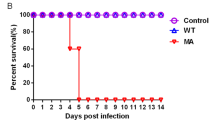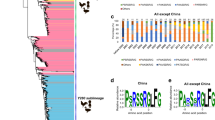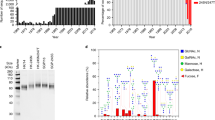Abstract
H10N8 follows H7N9 and H5N1 as the latest in a line of avian influenza viruses that cause serious disease in humans and have become a threat to public health1. Since December 2013, three human cases of H10N8 infection have been reported, two of whom are known to have died. To gather evidence relating to the epidemic potential of H10 we have determined the structure of the haemagglutinin of a previously isolated avian H10 virus and we present here results relating especially to its receptor-binding properties, as these are likely to be major determinants of virus transmissibility. Our results show, first, that the H10 virus possesses high avidity for human receptors and second, from the crystal structure of the complex formed by avian H10 haemagglutinin with human receptor, it is clear that the conformation of the bound receptor has characteristics of both the 1918 H1N1 pandemic virus2 and the human H7 viruses isolated from patients in 2013 (ref. 3). We conclude that avian H10N8 virus has sufficient avidity for human receptors to account for its infection of humans but that its preference for avian receptors should make avian-receptor-rich human airway mucins4 an effective block to widespread infection. In terms of surveillance, particular attention will be paid to the detection of mutations in the receptor-binding site of the H10 haemagglutinin that decrease its avidity for avian receptor, and could enable it to be more readily transmitted between humans.
This is a preview of subscription content, access via your institution
Access options
Subscribe to this journal
Receive 51 print issues and online access
$199.00 per year
only $3.90 per issue
Buy this article
- Purchase on Springer Link
- Instant access to full article PDF
Prices may be subject to local taxes which are calculated during checkout



Similar content being viewed by others
Change history
23 July 2014
An error was corrected in the legend for Extended Data Fig. 4.
References
Chen, H. et al. Clinical and epidemiological characteristics of a fatal case of avian influenza A H10N8 virus infection: a descriptive study. Lancet (2014)
Gamblin, S. J. et al. The structure and receptor binding properties of the 1918 influenza hemagglutinin. Science 303, 1838–1842 (2004)
Xiong, X. et al. Receptor binding by an H7N9 influenza virus from humans. Nature 499, 496–499 (2013)
Couceiro, J. N., Paulson, J. C. & Baum, L. G. Influenza virus strains selectively recognize sialyloligosaccharides on human respiratory epithelium; the role of the host cell in selection of hemagglutinin receptor specificity. Virus Res. 29, 155–165 (1993)
Liu, J. et al. Structures of receptor complexes formed by hemagglutinins from the Asian Influenza pandemic of 1957. Proc. Natl Acad. Sci. USA 106, 17175–17180 (2009)
Xu, R., McBride, R., Nycholat, C. M., Paulson, J. C. & Wilson, I. A. Structural characterization of the hemagglutinin receptor specificity from the 2009 H1N1 influenza pandemic. J. Virol. 86, 982–990 (2012)
Xu, R. & Wilson, I. A. Structural characterization of an early fusion intermediate of influenza virus hemagglutinin. J. Virol. 85, 5172–5182 (2011)
Ha, Y., Stevens, D. J., Skehel, J. J. & Wiley, D. C. X-ray structure of the hemagglutinin of a potential H3 avian progenitor of the 1968 Hong Kong pandemic influenza virus. Virology 309, 209–218 (2003)
Ha, Y., Stevens, D. J., Skehel, J. J. & Wiley, D. C. X-ray structures of H5 avian and H9 swine influenza virus hemagglutinins bound to avian and human receptor analogs. Proc. Natl Acad. Sci. USA 98, 11181–11186 (2001)
Zhang, W. et al. An airborne transmissible avian influenza H5 hemagglutinin seen at the atomic level. Science 340, 1463–1467 (2013)
Russell, R. J. et al. H1 and H7 influenza haemagglutinin structures extend a structural classification of haemagglutinin subtypes. Virology 325, 287–296 (2004)
Shi, Y. et al. Structures and receptor binding of hemagglutinins from human-infecting H7N9 influenza viruses. Science 342, 243–247 (2013)
Gambaryan, A. S. et al. 6-sulfo sialyl Lewis X is the common receptor determinant recognized by H5, H6, H7 and H9 influenza viruses of terrestrial poultry. Virol. J. 5, 85 (2008)
Matrosovich, M., Matrosovich, T., Uhlendorff, J., Garten, W. & Klenk, H. D. Avian-virus-like receptor specificity of the hemagglutinin impedes influenza virus replication in cultures of human airway epithelium. Virology 361, 384–390 (2007)
Rogers, G. N. et al. Host-mediated selection of influenza virus receptor variants. Sialic acid-α2,6Gal-specific clones of A/duck/Ukraine/1/63 revert to sialic acid-α2,3Gal-specific wild type in ovo. J. Biol. Chem. 260, 7362–7367 (1985)
Matrosovich, M. et al. Early alterations of the receptor-binding properties of H1, H2, and H3 avian influenza virus hemagglutinins after their introduction into mammals. J. Virol. 74, 8502–8512 (2000)
Keawcharoen, J. et al. Repository of Eurasian influenza A virus hemagglutinin and neuraminidase reverse genetics vectors and recombinant viruses. Vaccine 28, 5803–5809 (2010)
Reid, A. H., Fanning, T. G., Hultin, J. V. & Taubenberger, J. K. Origin and evolution of the 1918 “Spanish” influenza virus hemagglutinin gene. Proc. Natl Acad. Sci. USA 96, 1651–1656 (1999)
Eisen, M. B., Sabesan, S., Skehel, J. J. & Wiley, D. C. Binding of the influenza A virus to cell-surface receptors: structures of five hemagglutinin-sialyloligosaccharide complexes determined by X-ray crystallography. Virology 232, 19–31 (1997)
Xiong, X. et al. Recognition of sulphated and fucosylated receptor sialosides by A/Vietnam/1194/2004 (H5N1) influenza virus. Virus Res. 178, 12–14 (2013)
Skehel, J. J. & Schild, G. C. The polypeptide composition of influenza A viruses. Virology 44, 396–408 (1971)
Otwinowski, Z. & Minor, W. Data collection and processing. Proceedings of the CCP4 Study Weekend 556–562 (SERC Daresbury Laboratory, 1993)
McCoy, A. J. Solving structures of protein complexes by molecular replacement with Phaser. Acta Crystallogr. D 63, 32–41 (2007)
Emsley, P. & Cowtan, K. Coot: model-building tools for molecular graphics. Acta Crystallogr. D 60, 2126–2132 (2004)
Murshudov, G. N., Vagin, A. A. & Dodson, E. J. Refinement of macromolecular structures by the maximum-likelihood method. Acta Crystallogr. D Biol. Crystallogr. 53, 240–255 (1997)
Xiong, X. et al. Receptor binding by a ferret-transmissible H5 avian influenza virus. Nature 497, 392–396 (2013)
Lin, Y. P. et al. Evolution of the receptor binding properties of the influenza A(H3N2) hemagglutinin. Proc. Natl Acad. Sci. USA 109, 21474–21479 (2012)
Acknowledgements
We thank N. Bovin for gifts of sulphated sialoside. We greatly acknowledge Diamond Light Source for access to synchrotron time under proposal 7707. This work was funded by the Medical Research Council through programmes U117584222, U117570592 and U117585868.
Author information
Authors and Affiliations
Contributions
All authors performed experiments and contributed to the writing of the manuscript.
Corresponding authors
Ethics declarations
Competing interests
The authors declare no competing financial interests.
Extended data figures and tables
Extended Data Figure 1 The structures of avian H10 HA and human H10 HA.
a, The structure of avian H10 HA trimer with one subunit coloured blue (HA1) and one coloured red (HA2), and the other two coloured grey. The locations of amino acid sequence differences between the HAs of A/mallard/Sweden/51/2002(H10N2) and A/Jiangxi-Donghu/346/2013 (H10N8) from humans are indicated by green spheres and numbered by alignment with H3 sequences. b, Receptor-binding site of human H10 HA (purple) compared to that of avian H10 HA (blue). The structure of the human H10 has been determined to 2.5 Å. Human receptors bound to avian H10 are coloured yellow (Sia-1), blue (Gal-2) and red (NAG-3), whereas the equivalents from the human H10 complex are shown in lighter shades. Potential hydrogen bonds between Arg 137 of human H10 and the human receptor are indicated by dashed lines. The arginine residue potentially also makes other hydrogen bonds (not shown) including to the glycosidic oxygen. The crystallographic asymmetric unit contains one HA trimer, the figure shows the A-chain monomer which was selected on the basis of not being involved in a close crystal contact and for having well-ordered electron density for the arginine. c, Binding of NT647-labelled human H10 to 3′-SLN (red symbols) and 6′-SLN (blue symbols). The calculated Kds were 1.81 ± 0.39 mM and 1.39 ± 0.32 mM, respectively.
Extended Data Figure 2 Biolayer interferometry measurements of binding avidity.
Biolayer interferometry binding data for A/mallard/Sweden/51/2002 (H10N2) virus (ref. 17) to sulphated 3′-SLN (purple), sulphated SLeX (green), 3′-SLN (red), SLeX (orange) and 6′-SLN (blue).
Extended Data Figure 3 Structural comparison of the H10 and H5 HA binding sites.
A comparison of the receptor-binding sites of H10 (a) and H5 (b) (ref. 20) HAs from complexes formed between the HAs and sulphated 3′-SLN. Electron density (2Fc – Fo, 0.8σ) for the receptor is shown in a. In H10 HA the sulphate group approaches Lys 158A, the first inserted residue in the 150-loop. By contrast, in H5 HA the sulphate approaches Lys 193 in the 190-helix (b) (the equivalent residue in H10 HA is aspartic acid).
Extended Data Figure 4 Comparison of H10 and H1 HA in complex with avian and human receptors.
Comparisons of avian- and human-receptor-bound forms of H10 (a) and H1 (b) HAs. The arrows indicate the upward movement of Gln 226 in the complexes formed with avian receptor.
Rights and permissions
About this article
Cite this article
Vachieri, S., Xiong, X., Collins, P. et al. Receptor binding by H10 influenza viruses. Nature 511, 475–477 (2014). https://doi.org/10.1038/nature13443
Received:
Accepted:
Published:
Issue Date:
DOI: https://doi.org/10.1038/nature13443
This article is cited by
-
Human-type sialic acid receptors contribute to avian influenza A virus binding and entry by hetero-multivalent interactions
Nature Communications (2022)
-
Establishment and evaluation of a theater influenza monitoring platform
Military Medical Research (2017)
-
Variability in H9N2 haemagglutinin receptor-binding preference and the pH of fusion
Emerging Microbes & Infections (2017)
-
Genetic properties and pathogenicity of a novel reassortant H10N5 influenza virus from wild birds
Archives of Virology (2017)
-
Novel avian influenza A (H5N6) viruses isolated in migratory waterfowl before the first human case reported in China, 2014
Scientific Reports (2016)
Comments
By submitting a comment you agree to abide by our Terms and Community Guidelines. If you find something abusive or that does not comply with our terms or guidelines please flag it as inappropriate.



